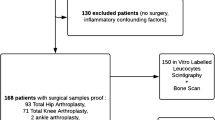Summary.
When infection of implants is suspected, optimal management requires accurate confirmation or exclusion of infection. However, in spite of demonstrative clinical signs cultures of smears or chemical parameters of inflammation frequently are ambiguous. Scintigraphy with indium-labeled white blood cells (WBC) has been reported to be sensitive and specific in the diagnosis of low-grade sepsis of the musculoskeletal system. Twenty-eight patients with possible infection were prospectively studied. Infection was suspected in 19 cases with total hip joint prosthesis, 14 cases with knee joint prosthesis and 1 case with shoulder joint prosthesis. All of them underwent scanning with indium-111-labeled WBC and subsequently underwent surgery. At surgery infections were determined by means of culture or histologic results. When correlated with culture and histologic results sensitivity of 111-indium-WBC imaging was 89 %, with a specifity of 67 % and a predictive accuracy of 77 %. In patients with rheumatoid arthritis, however, predictive accuracy of 111-indium-labeled WBC imaging was higher than with standard diagnostic methods. The difference was statistically significant (P < 0.05, χ 2-test). In the patients examined as a whole, predictive accuracy of 111-indium-labeled WBC imaging does not differ from that of standard diagnostic methods. That is why expensive and time-consuming 111-indium-WBC imaging is not justified generally in diagnosis of infection of implants. 111-Indium-WBC imaging is well suited to supplement standard diagnostic methods in patients with rheumatoid arthritis.
Zusammenfassung.
Bei Verdacht auf Implantatinfekt finden sich trotz hinweisender Klinik häufig uneinheitliche Laborwerte, Punktate sind nicht selten steril. Eine gesicherte Diagnose bestimmt jedoch das weitere Vorgehen. Als Entscheidungshilfe bietet sich die Leukocytenszintigraphie an. In der vorliegenden kontrollierten prospektiven Studie wurden bei 28 Patienten mit Verdacht auf Implantatinfekt insgesamt 34 Leukocytenszintigraphien mit Indium-111 durchgeführt. Das Patientenkollektiv bestand zu 50 % aus Patienten mit einer chronischen Polyarthritis, bei denen sich die Standarddiagnostik des Implantatinfekts besonders problematisch erwies. Der Verdacht wurde 19mal bei einer Hüftendoprothese, 14mal bei einer Knieendoprothese und einmal bei einer Schulterendoprothese gestellt. Die Verifizierung der Verdachtsdiagnose erfolgte in allen Fällen durch eine bakteriologische und histologische Untersuchung aus intraoperativ gewonnenem Material. Bei der Berechnung der Methodengenauigkeit ergibt sich eine Sensitivität von 89 %, eine Spezifität von 67 %, ein positiv prädiktiver Wert von 77 %, ein negativ prädiktiver Wert von 83 % und eine Treffsicherheit von 79 %. Die Leukocytenszintigraphie kann damit die Standarddiagnostik bei Verdacht auf Implantatinfekt nicht ersetzen. Da sie für das Gesamtkollektiv keine signifikant höhere Treffsicherheit (p < 0,05, χ 2-Test) liefert als der Infektionsscore nach Zimmerli, ist sie als teure und aufwendige Methode nicht generell bei Verdacht auf Implantatinfekt gerechtfertigt. Ihre Indikation ergibt sich jedoch bei Patienten mit chronischer Polyarthritis, bei denen die Leukocytenszintigraphie treffsicherer ist als der Infektionsscore (p < 0,05, χ 2-Test).
Similar content being viewed by others
Author information
Authors and Affiliations
Rights and permissions
About this article
Cite this article
Lazovic, D., Carls, J., Flöel, A. et al. Nutzen der Leukocytenszintigraphie bei Verdacht auf Implantatinfekt bei Patienten mit chronischer Polyarthritis. Chirurg 68, 1181–1186 (1997). https://doi.org/10.1007/s001040050342
Issue Date:
DOI: https://doi.org/10.1007/s001040050342



